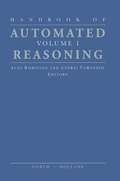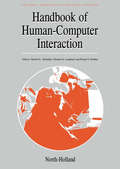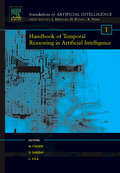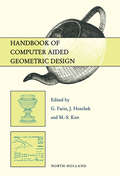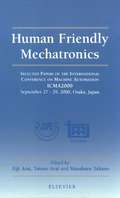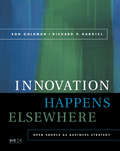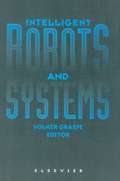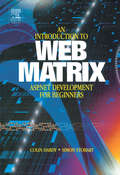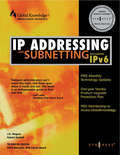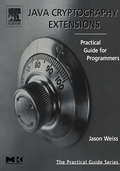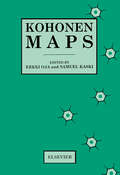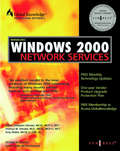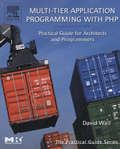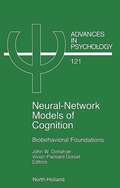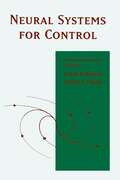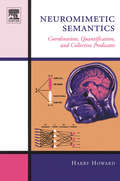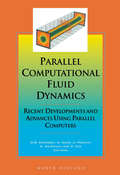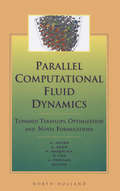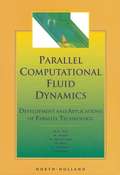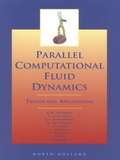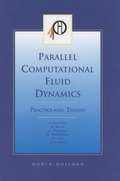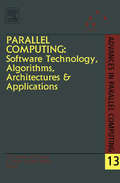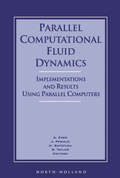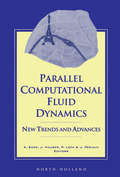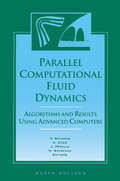- Table View
- List View
Handbook of Automated Reasoning (Handbook of Automated Reasoning #Volume 1)
by Andrei Voronkov Alan RobinsonHandbook of Automated Reasoning
Handbook of Human-Computer Interaction
by M. G. Helander T. K. Landauer P. V. PrabhuThis completely revised edition, of the Handbook of Human-Computer Interaction, of which 80% of the content is new, reflects the developments in the field since the publication of the first edition in 1988. The handbook is concerned with principles for design of the Human-Computer Interface, and has both academic and practical purposes. It is intended to summarize the research and provide recommendations for how the information can be used by designers of computer systems. The volume may also be used as a reference for teaching and research. Professionals who are involved in design of HCI will find this volume indispensable, including: computer scientists, cognitive scientists, experimental psychologists, human factors professionals, interface designers, systems engineers, managers and executives working with systems development. Much of the information in the handbook may also be generalized to apply to areas outside the traditional field of HCI.
Handbook of Temporal Reasoning in Artificial Intelligence (ISSN #Volume 1)
by Dov M. Gabbay Michael David Fisher Lluis VilaThis collection represents the primary reference work for researchers and students in the area of Temporal Reasoning in Artificial Intelligence. Temporal reasoning has a vital role to play in many areas, particularly Artificial Intelligence. Yet, until now, there has been no single volume collecting together the breadth of work in this area. This collection brings together the leading researchers in a range of relevant areas and provides an coherent description of the breadth of activity concerning temporal reasoning in the filed of Artificial Intelligence.Key Features:- Broad range: foundations; techniques and applications- Leading researchers around the world have written the chapters- Covers many vital applications- Source book for Artificial Intelligence, temporal reasoning- Approaches provide foundation for many future software systems· Broad range: foundations; techniques and applications· Leading researchers around the world have written the chapters· Covers many vital applications· Source book for Artificial Intelligence, temporal reasoning· Approaches provide foundation for many future software systems
Handbook of Computer Aided Geometric Design
by G. Farin J. Hoschek M.-S. KimThis book provides a comprehensive coverage of the fields Geometric Modeling, Computer-Aided Design, and Scientific Visualization, or Computer-Aided Geometric Design. Leading international experts have contributed, thus creating a one-of-a-kind collection of authoritative articles. There are chapters outlining basic theory in tutorial style, as well as application-oriented articles. Aspects which are covered include: Historical outline Curve and surface methods Scientific Visualization Implicit methods Reverse engineering.This book is meant to be a reference text for researchers in the field as well as an introduction to graduate students wishing to get some exposureto this subject.
Human Friendly Mechatronics
by Tatsuo Arai Eiji Arai Masaharu TakanoThe book includes 61 selected papers from 106 presented at the second International Conference on Machine Automation (ICMA2000). The conference focused, for the first time, on human friendly mechantronics which covers machine systems interacting with human beings, psychological, physiological, and physical behaviors of the human being itself, robotics, human-mimetic mechanical systems, commercial application examples and so on. Machine automation has owed a lot to mechatronics technology in the last decades, however, a paradigm shift is desired and emphasized in the 21st century in every aspect of our society, and mechantronics is not an exception. The paradigm shift in mechatronics is a pursuit of productivity and efficiency to the preference of humans, and it is time that a new concept of a human friendly robot must be proposed that is welcome by human users. The book aims to offer the most up-to-date and valuable information on: •Human Interface & Communication •Human Support Technology •Actuator & Control •Vision & Sensing •Robotics and Design •Manufacturing System We believe this book will bring advanced knowledge and valuable information to the industries as well as to academics and will contribute to the further development in mechatronics and its related fields.
Innovation Happens Elsewhere: Open Source as Business Strategy
by Ron Goldman Richard P. GabrielIt's a plain fact: regardless of how smart, creative, and innovative your organization is, there are more smart, creative, and innovative people outside your organization than inside. Open source offers the possibility of bringing more innovation into your business by building a creative community that reaches beyond the barriers of the business. The key is developing a web-driven community where new types of collaboration and creativity can flourish. Since 1998 Ron Goldman and Richard Gabriel have been helping groups at Sun Microsystems understand open source and advising them on how to build successful communities around open source projects. In this book the authors present lessons learned from their own experiences with open source, as well as those from other well-known projects such as Linux, Apache, and Mozilla.* Winner of 2006 Jolt Productivity Award for General Books* Describes how open source development works and offers persuasive reasons for using it to help achieve business goals.* Shows how to use open source in day-to-day work, discusses the various licenses in use, and describes what makes for a successful project.* Written in an engaging style for executives, managers, and engineers that addresses the human and business issues involved in open source development as well as its history, philosophy, and future
Intelligent Robots and Systems
by V. GraefeOf the 300 papers presented during IROS '94, 48 were selected because they are particularly significant and characteristic for the present state of the technology of intelligent robots and systems. This book contains the selected papers in a revised and expanded form.Robotics and intelligent systems constitute a very wide and truly interdisciplinary field. The papers have been grouped into the following categories:– Sensing and Perception – Learning and Planning– Manipulation– Telerobotics and Space Robotics– Multiple Robots– Legged Locomotion– Mobile Robot Systems– Robotics in MedicineOther additional fields covered include; control, navigation and simulation. Since many researchers in robotics are now apparently interested in some combination of learning, mobile robots and robot vision, most of the articles included relate to at least one of these fields.
Introduction to Web Matrix: ASP.NET Development for Beginners
by Colin Hardy Simon StobartAn Introduction to Web Matrix provides an easy to follow treatment of the application of this new software, which is rapidly becoming the preferred vehicle for the teaching of website design. Written by two experienced users, the material is presented in a way that makes it ideal for students meeting the subject for the first time, whether they are on an undergraduate or postgraduate course. The scope of the book includes the functionality of the software, its installation and application and the design and operation of web-based material using it. Coverage of the use of HTML and SQL is also included, as is the design and implementation of on-line databases.There are numerous examples to illustrate ideas and concepts. The examples provide a practical illustration of how the software may be used. At the conclusion of each chapter, a set of exercises is provided to allow the reader to review and practice the material presented.* A simple introduction for users with no previous experience of the design process* Abundant screen dumps and diagrams aid fast assimilation of the material* Accompanying website with a wide range of facilities
IP Addressing and Subnetting INC IPV6: Including IPv6
by SyngressInternetworking Protocol (IP) addresses are the unique numeric identifiers required of every device connected to the Internet. They allow for the precise routing of data across very complex worldwide internetworks. The rules for their format and use are governed by the Internet Engineering Task Force (IETF) of the The Internet SOCiety (ISOC). In response to the exponential increase in demand for new IP addresses, the IETF has finalized its revision on IP addressing as IP Version 6, also know as IPng (ng = Next Generation). Key hardware vendors such as Cisco and major Internet Service Providers such as America Online have already announced plans to migrate to IP Version 6.IP address allocation within an organization requires a lot of long-term planning. This timely publication addresses the administrator and engineer's need to know how IP 6 impacts their enterprise networks.Easy-to-read, light technical approach to cellular technologyIdeal for companies planning a phased migration from IP 4 to IP 6Timely publication: The IETF standard was finalized in early 1999 and will begin to be implemented in late 1999/2000. The current IP Version 4 address set will be exhausted by 2003The book focuses on planning and configuring networks and devices for IP 6. Specifically, it will cover how to: Increase the IP address size from 32 bits to 128 bits; Support more levels of addressing hierarchy; Support an increased number of addressable nodes; Support simpler auto-configuration of addresses; Improve the scalability of multicast routing by adding a "scope" field to multicast addresses; Use a new "anycast address" to send a packet to any one of a group of nodes
Java Cryptography Extensions: Practical Guide for Programmers (The Practical Guides)
by Jason R. WeissFor a long time, there has been a need for a practical, down-to-earth developers book for the Java Cryptography Extension. I am very happy to see there is now a book that can answer many of the technical questions that developers, managers, and researchers have about such a critical topic. I am sure that this book will contribute greatly to the success of securing Java applications and deployments for e-business. --Anthony Nadalin, Java Security Lead Architect, IBMFor many Java developers and software engineers, cryptography is an "on-demand" programming exercise, where cryptographic concepts are shelved until the next project requires renewed focus. But considerations for cryptography must be made early on in the design process and it’s imperative that developers know what kinds of solutions exist. One of Java’s solutions to help bridge the gap between academic research and real-world problem solving comes in the form of a well-defined architecture for implementing cryptographic solutions. However, to use the architecture and its extensions, it is important to recognize the pros and cons of different cryptographic algorithms and to know how to implement various devices like key agreements, digital signatures, and message digests, to name a few.In Java Cryptography Extensions (JCE), cryptography is discussed at the level that developers need to know to work with the JCE and with their own applications but that doesn’t overwhelm by packing in details unimportant to the busy professional. The JCE is explored using numerous code examples and instructional detail, with clearly presented sections on each aspect of the Java library. An online open-source cryptography toolkit and the code for all of the examples further reinforces the concepts covered within the book. No other resource presents so concisely or effectively the exact material needed to begin utilizing the JCE.Written by a seasoned veteran of both cryptography and server-side programmingCovers the architecture of the JCE, symmetric ciphers, asymmetric ciphers, message digests, message authentication codes, digital signatures, and managing keys and certificates
Kohonen Maps
by E. Oja Samuel KaskiThe Self-Organizing Map, or Kohonen Map, is one of the most widely used neural network algorithms, with thousands of applications covered in the literature. It was one of the strong underlying factors in the popularity of neural networks starting in the early 80's. Currently this method has been included in a large number of commercial and public domain software packages. In this book, top experts on the SOM method take a look at the state of the art and the future of this computing paradigm.The 30 chapters of this book cover the current status of SOM theory, such as connections of SOM to clustering, classification, probabilistic models, and energy functions. Many applications of the SOM are given, with data mining and exploratory data analysis the central topic, applied to large databases of financial data, medical data, free-form text documents, digital images, speech, and process measurements. Biological models related to the SOM are also discussed.
Managing Windows 2000 Network Services
by SyngressMany organizations and network administrators are looking for information on Windows 2000 and its new features. IT professionals responsible for installing, configuring and managing Microsoft products will be highly motivated to migrate to this new technology, based on its promise of reducing administrative overhead.Microsoft Windows 2000 Server (the predecessor to Windows NT 4 Server) integrates network services for companies and administrators to set up and manage networks, remote access and extranets, as well as to manage other communications. Managing Windows 2000 Network Services will be the first book to focus exclusively on networking and integrated voice, video, and data on networks. Readers will learn how to deploy and integrate all Windows 2000 networking technologies within an enterprise network.* The publication of the book will be with or soon after the release of Windows 2000* Focuses completely on Network Services
Multi-Tier Application Programming with PHP: Practical Guide for Architects and Programmers (The Practical Guides)
by David WallWhile many architects use PHP for projects, they are often not aware of the power of PHP in creating enterprise-level applications. This book covers the latest version of PHP – version 5 -- and focuses on its capabilities within a multi-tier application framework. It contains numerous coding samples and commentaries on them. A chapter discusses object orientation in PHP as it applies to the multi-tier architecture and other chapters discuss HTTP and SOAP, the two communication protocols most useful in tying together multiple layers. There is also coverage of database design and query construction as well as information about tricks you can use in generating user interfaces.Covers PHP as it relates to developing software in a multi-tier environment—a crucial aspect of developing robust software with low cost and ease of use as design goals. Makes extensive use of Simple Object Access Protocol (SOAP) and Web Services as implemented in PHP and NuSOAP.Shows precisely how to make use of the InnoDB table type newly available in MySQL. InnoDB supports true referential integrity and row-level locking.An application example (a multi-currency bookkeeping application) runs throughout the book, showing various PHP capabilities as well as the database interaction.
Neural Network Models of Cognition: Biobehavioral Foundations (ISSN #Volume 121)
by J. W. Donahoe V. P. DorselThis internationally authored volume presents major findings, concepts, and methods of behavioral neuroscience coordinated with their simulation via neural networks. A central theme is that biobehaviorally constrained simulations provide a rigorous means to explore the implications of relatively simple processes for the understanding of cognition (complex behavior). Neural networks are held to serve the same function for behavioral neuroscience as population genetics for evolutionary science. The volume is divided into six sections, each of which includes both experimental and simulation research: (1) neurodevelopment and genetic algorithms, (2) synaptic plasticity (LTP), (3) sensory/hippocampal systems, (4) motor systems, (5) plasticity in large neural systems (reinforcement learning), and (6) neural imaging and language. The volume also includes an integrated reference section and a comprehensive index.
Neural Systems for Control
by Omid Omidvar David L. ElliottControl problems offer an industrially important application and a guide to understanding control systems for those working in Neural Networks. Neural Systems for Control represents the most up-to-date developments in the rapidly growing aplication area of neural networks and focuses on research in natural and artifical neural systems directly applicable to control or making use of modern control theory. The book covers such important new developments in control systems such as intelligent sensors in semiconductor wafer manufacturing; the relation between muscles and cerebral neurons in speech recognition; online compensation of reconfigurable control for spacecraft aircraft and other systems; applications to rolling mills, robotics and process control; the usage of past output data to identify nonlinear systems by neural networks; neural approximate optimal control; model-free nonlinear control; and neural control based on a regulation of physiological investigation/blood pressure control. All researchers and students dealing with control systems will find the fascinating Neural Systems for Control of immense interest and assistance.Focuses on research in natural and artifical neural systems directly applicable to contol or making use of modern control theoryRepresents the most up-to-date developments in this rapidly growing application area of neural networksTakes a new and novel approach to system identification and synthesis
Neuromimetic Semantics: Coordination, quantification, and collective predicates
by Harry HowardThis book attempts to marry truth-conditional semantics with cognitive linguistics in the church of computational neuroscience. To this end, it examines the truth-conditional meanings of coordinators, quantifiers, and collective predicates as neurophysiological phenomena that are amenable to a neurocomputational analysis. Drawing inspiration from work on visual processing, and especially the simple/complex cell distinction in early vision (V1), we claim that a similar two-layer architecture is sufficient to learn the truth-conditional meanings of the logical coordinators and logical quantifiers. As a prerequisite, much discussion is given over to what a neurologically plausible representation of the meanings of these items would look like. We eventually settle on a representation in terms of correlation, so that, for instance, the semantic input to the universal operators (e.g. and, all)is represented as maximally correlated, while the semantic input to the universal negative operators (e.g. nor, no)is represented as maximally anticorrelated. On the basis this representation, the hypothesis can be offered that the function of the logical operators is to extract an invariant feature from natural situations, that of degree of correlation between parts of the situation. This result sets up an elegant formal analogy to recent models of visual processing, which argue that the function of early vision is to reduce the redundancy inherent in natural images. Computational simulations are designed in which the logical operators are learned by associating their phonological form with some degree of correlation in the inputs, so that the overall function of the system is as a simple kind of pattern recognition. Several learning rules are assayed, especially those of the Hebbian sort, which are the ones with the most neurological support. Learning vector quantization (LVQ) is shown to be a perspicuous and efficient means of learning the patterns that are of interest. We draw a formal parallelism between the initial, competitive layer of LVQ and the simple cell layer in V1, and between the final, linear layer of LVQ and the complex cell layer in V1, in that the initial layers are both selective, while the final layers both generalize. It is also shown how the representations argued for can be used to draw the traditionally-recognized inferences arising from coordination and quantification, and why the inference of subalternacy breaks down for collective predicates. Finally, the analogies between early vision and the logical operators allow us to advance the claim of cognitive linguistics that language is not processed by proprietary algorithms, but rather by algorithms that are general to the entire brain. Thus in the debate between objectivist and experiential metaphysics, this book falls squarely into the camp of the latter. Yet it does so by means of a rigorous formal, mathematical, and neurological exposition – in contradiction of the experiential claim that formal analysis has no place in the understanding of cognition. To make our own counter-claim as explicit as possible, we present a sketch of the LVQ structure in terms of mereotopology, in which the initial layer of the network performs topological operations, while the final layer performs mereological operations.
Parallel Computational Fluid Dynamics '97: Recent Developments and Advances Using Parallel Computers
by A. Ecer Jacques Periaux D. Emerson P. Fox N. SatofukaComputational Fluid Dynamics (CFD) is a discipline that has always been in the vanguard of the exploitation of emerging and developing technologies. Advances in both algorithms and computers have rapidly been absorbed by the CFD community in its quest for more accurate simulations and reductions in the time to solution. Within this context, parallel computing has played an increasingly important role. Moreover, the uptake of parallel computing has brought the CFD community into ever-closer contact with hardware vendors and computer scientists. The multidisciplinary subject of parallel CFD and its rapidly evolving nature, in terms of hardware and software, requires a regular international meeting of this nature to keep abreast of the most recent developments.Parallel CFD '97 is part of an annual conference series dedicated to the discussion of recent developments and applications of parallel computing in the field of CFD and related disciplines. This was the 9th in the series, and since the inaugural conference in 1989, many new developments and technologies have emerged. The intervening years have also proved to be extremely volatile for many hardware vendors and a number of companies appeared and then disappeared. However, the belief that parallel computing is the only way forward has remained undiminished. Moreover, the increasing reliability and acceptance of parallel computers has seen many commercial companies now offering parallel versions of their codes, many developed within the EC funded EUROPORT activity, but generally for more modest numbers of processors. It is clear that industry has not moved to large scale parallel systems but it has shown a keen interest in more modest parallel systems recognising that parallel computing will play an important role in the future. This book forms the proceedings of the CFD '97 conference, which was organised by the the Computational Engineering Group at Daresbury Laboratory and held in Manchester, England, on May 19-21 1997. The sessions involved papers on many diverse subjects including turbulence, reactive flows, adaptive schemes, unsteady flows, unstructured mesh applications, industrial applications, developments in software tools and environments, climate modelling, parallel algorithms, evaluation of computer architectures and a special session devoted to parallel CFD at the AEREA research centres. This year's conference, like its predecessors, saw a continued improvement in both the quantity and quality of contributed papers.Since the conference series began many significant milestones have been acheived. For example in 1994, Massively Parallel Processing (MPP) became a reality with the advent of Cray T3D. This, of course, has brought with it the new challenge of scalability for both algorithms and architectures. In the 12 months since the 1996 conference, two more major milestones were achieved: microprocessors with a peak performance of a Gflop/s became available and the world's first Tflop/s calculation was performed. In the 1991 proceedings, the editors indicated that a Tflop/s computer was likely to be available in the latter half of this decade. On December 4th 1996, Intel achieved this breakthrough on the Linpack benchmark using 7,264 (200MHz) Pentium Pro microprocessors as part of the ASCI Red project. With the developments in MPP, the rapid rise of SMP architectures and advances in PC technology, the future for parallel CFD looks both promising and challenging.
Parallel Computational Fluid Dynamics '99: Towards Teraflops, Optimization and Novel Formulations
by Jacques Periaux P. Fox A. Ecer N. Satofuka D. KeyesContributed presentations were given by over 50 researchers representing the state of parallel CFD art and architecture from Asia, Europe, and North America. Major developments at the 1999 meeting were: (1) the effective use of as many as 2048 processors in implicit computations in CFD, (2) the acceptance that parallelism is now the 'easy part' of large-scale CFD compared to the difficulty of getting good per-node performance on the latest fast-clocked commodity processors with cache-based memory systems, (3) favorable prospects for Lattice-Boltzmann computations in CFD (especially for problems that Eulerian and even Lagrangian techniques do not handle well, such as two-phase flows and flows with exceedingly multiple-connected demains with a lot of holes in them, but even for conventional flows already handled well with the continuum-based approaches of PDEs), and (4) the nascent integration of optimization and very large-scale CFD. Further details of Parallel CFD'99, as well as other conferences in this series, are available at http://www.parcfd.org
Parallel Computational Fluid Dynamics '98: Development and Applications of Parallel Technology
by Jacques Periaux P. Fox A. Ecer N. Satofuka Chiao-Ling LinThis book contains the papers presented at the Parallel Computational Fluid Dynamics 1998 Conference. The book is focused on new developments and applications of parallel technology. Key topics are introduced through contributed papers and invited lectures. These include typical algorithmic developments, such as: distributed computing, domain decomposition and parallel algorithm. Some of the papers address the evaluations of software and machine performance and software tool environments. The application of parallel computers to complex fluid dynamics problems are also conveyed through sessions such as DNS/LES, combustion and reacting flows, industrial applications, water resources and environmental flows.The editors believe this book will provide many researchers, much beyond those contributing to this volume, with fresh information and reference.
Parallel Computational Fluid Dynamics 2000: Trends and Applications
by Jacques Periaux P. Fox A. Ecer N. Satofuka C.B. Jenssen T. Kvamdal H.I. Andersson B. PettersenParallel CFD 2000, the Twelfth in an International series of meetings featuring computational fluid dynamics research on parallel computers, was held May 22-25, 2000 in Trondheim, Norway. Following the trend of the past conferences, areas such as numerical schemes and algorithms, tools and environments, load balancing, as well as interdisciplinary topics and various kinds of industrial applications were all well represented in the work presented. In addition, for the first time in the Parallel CFD conference series, the organizing committee chose to draw special attention to certain subject areas by organizing a number of special sessions. We feel the emphasis of the papers presented at the conference reflect the direction of the research within parallel CFD at the beginning of the new millennium. It seems to be a clear tendency towards increased industrial exploitation of parallel CFD. Several presentations also demonstrated how new insight is being achieved from complex simulations, and how powerful parallel computers now make it possible to use CFD within a broader interdisciplinary setting. Obviously, successful application of parallel CFD still rests on the underlying fundamental principles. Therefore, numerical algorithms, development tools, and parallelization techniques are still as important as when parallel CFD was in is infancy. Furthermore, the novel concepts of affordable parallel computing as well as metacomputing show that exciting developments are still taking place. As is often pointed out however, the real power of parallel CFD comes from the combination of all the disciplines involved: Physics, mathematics, and computer science. This is probably one of the principal reasons for the continued popularity of the Parallel CFD Conferences series, as well as the inspiration behind much of the excellent work carried out on the subject. We hope that the papers in this book, both on an individual basis and as a whole, will contribute to that inspiration. Further details of Parallel CFD'99, as well as other conferences in this series, are available at http://www.parcfd.org
Parallel Computational Fluid Dynamics 2001, Practice and Theory
by Jacques Periaux P. Wilders P. Fox A. Ecer N. SatofukaParCFD 2001, the thirteenth international conference on Parallel Computational Fluid Dynamics took place in Egmond aan Zee, the Netherlands, from May 21-23, 2001. The specialized, high-level ParCFD conferences are organized yearly on traveling locations all over the world. A strong back-up is given by the central organization located in the USA http://www.parcfd.org. These proceedings of ParCFD 2001 represent 70% of the oral lectures presented at the meeting. All published papers were subjected to a refereeing process, which resulted in a uniformly high quality. The papers cover not only the traditional areas of the ParCFD conferences, e.g. numerical schemes and algorithms, tools and environments, interdisciplinary topics, industrial applications, but, following local interests, also environmental and medical issues. These proceedings present an up-to-date overview of the state of the art in parallel computational fluid dynamics.
Parallel Computing: Proceedings of the International Conference ParCo2003, Dresden, Germany (ISSN #Volume 13)
by Gerhard Joubert Wolfgang Nagel Frans Peters Wolfgang WalterAdvances in Parallel Computing series presents the theory and use of of parallel computer systems, including vector, pipeline, array, fifth and future generation computers and neural computers. This volume features original research work, as well as accounts on practical experience with and techniques for the use of parallel computers.
Parallel Computational Fluid Dynamics '95: Implementations and Results Using Parallel Computers
by A. Ecer N. Satofuka Jacques Periaux S. TaylorParallel Computational Fluid Dynamics(CFD) is an internationally recognised fast-growing field. Since 1989, the number of participants attending Parallel CFD Conferences has doubled.In order to keep track of current global developments, the Parallel CFD Conference annually brings scientists together to discuss and report results on the utilization of parallel computing as a practical computational tool for solving complex fluid dynamic problems. This volume contains the results of research conducted during the past year.Subject areas covered include: novel parallel algorithms, parallel Euler and Navier-Stokes solvers, parallel Direct Simulation Monte Carlo method and parallel multigrid techniques. The content of the book also demonstrates that considerable effort is being made to utilize parallel computing to solve a variety of fluid dynamics problems in topics such as climate modeling, consultation, aerodynamics and in many other areas.Readers of this book will gain a valid insight into the exciting recent developments in Parallel CFD research.
Parallel Computational Fluid Dynamics '93: New Trends and Advances
by P. Leca A. Ecer Jacques Periaux J. HauserThis volume contains the papers presented at the Parallel Computing Fluid Dynamics '93 Conference, Paris, 1993. A wide range of topics are covered including: networked computers, data parallel programming, domain decomposition, Euler and Navier-Stokes solvers.Researchers in this area will find this volume a useful reference in this rapidly developing field.
Parallel Computational Fluid Dynamics '96: Algorithms and Results Using Advanced Computers
by P. Schiano N. Satofuka A. Ecer Jacques PeriauxIn the last decade parallel computing has been put forward as the only computational answer to the increasing computational needs arising from very large and complex fluid dynamic problems. Considerable efforts are being made to use parallel computers efficiently to solve several fluid dynamic problems originating in aerospace, climate modelling and environmental applications.Parallel CFD Conferences are international and aim to increase discussion among researchers worldwide.Topics covered in this particular book include typical CFD areas such as turbulence, Navier-Stokes and Euler solvers, reactive flows, with a good balance between both university and industrial applications. In addition, other applications making extensive use of CFD such as climate modelling and environmental applications are also included.Anyone involved in the challenging field of Parallel Computational Fluid Dynamics will find this volume useful in their daily work.
